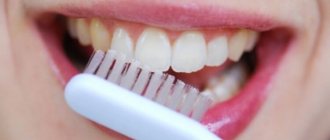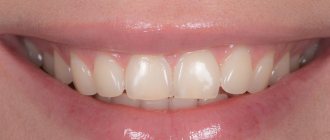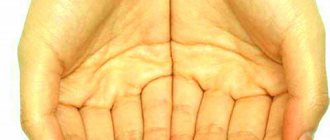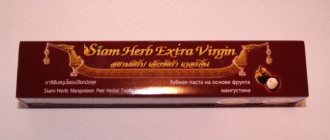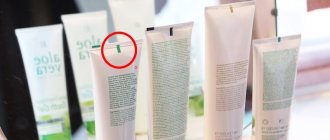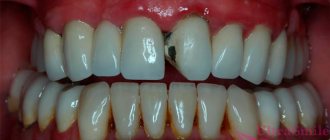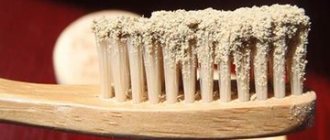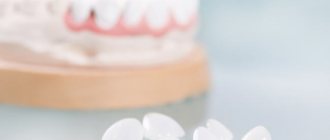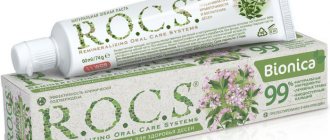20.10.2021
Author: Dentist Anna Vasilievna Danilets
I often hear debates about fluoride toothpastes - can I use them or not? Let's look at this issue in more detail. In our body, photor is contained in tooth enamel and bones about 2.5–3 g. Our daily requirement is 1.5–5 mg. A deficiency of this important element increases the risk of caries formation. Many people hear the word fluoride and say it's poison! And they're right: fluoride is a toxic gas. But few people know that fluorine is used in food and hygiene products not in its pure form, but in the form of salts (sodium or calcium fluorides).
Beneficial properties of fluorine: - together with calcium and phosphorus, promotes the formation and strengthening of bone tissue and tooth enamel; - stimulates nail and hair growth; — strengthens the immune system — removes heavy metal salts from the body; - Helps absorb iron.
Fluoride in toothpaste: benefit or harm?
The war against fluoride in dentistry began in the middle of the last century in the United States. More precisely, this country was the first to begin fluoridating drinking water in order to strengthen the population’s tooth enamel. Then, in 1969, the technique received WHO approval, and many countries around the world began to adopt advanced American experience. Only after a wave of fluorosis (a chronic disease caused by excess fluoride in the body and affecting not only teeth, but also skeletal bones) swept America in the 70s, the feasibility of water fluoridation was called into question. Despite the fact that at the beginning of the 21st century, reputable scientists, including the Australian researcher W. Evans, came out in support of fluoridation, discussions about the benefits of fluoride in medical circles continue to this day.
So is fluoride in toothpaste actually harmful, or are rumors about its negative effects on humans greatly exaggerated? Let's try to dot all the i's in this issue.
Prevention of oral diseases
Tooth and gum diseases can be prevented by regular oral hygiene. When rinsing with warm water after each meal, add a drop of lemon juice to the water. Hydroalcoholic extracts of medicinal plants are useful - for example, chamomile and calendula. Chew your food thoroughly...Solid foods naturally massage and strengthen your gums, improve circulation and reduce the risk of oral disease. Many microorganisms live in the mouth. If oral hygiene is not observed, teeth, gums and mucous membranes hurt. The infection spreads throughout the body, penetrates the internal organs, causes arthritis, hearing impairment, and smell impairment. Microbial waste enters the bloodstream, placing increased stress on the kidneys, heart, and digestive system. Caries is the softening and destruction of tooth tissue, causing a cavity to form inside the tooth. The exact cause of the disease is unknown, the most likely are hereditary predisposition, abuse of sweets, baked goods, deficiency of calcium, fluorine, phosphorus, poor oral hygiene, which slows down the development of caries.
Gingivitis affects the gums, the development of pathology is facilitated by dysfunction of the endocrine system, malocclusion railway siding Razinsky
The gums are itchy, swollen, and there is bleeding between the teeth. The shape of the wounds is bad. The treatment uses antiseptic rinsing solutions and scrapes off periodontal pockets. Stomatitis. The inflammatory process in the mucous membrane often develops after measles and viral diseases. Triggered by vitamin deficiency, general intoxication, diseases of the digestive, endocrine, nervous system, disorders, and inappropriate oral hygiene. Stomatitis develops after mechanical damage to the mucous membrane, the wound turns into a non-healing ulcer. The gums hurt, swell and bleed, with a characteristic white color... The disease is treated with antiseptics, taking multivitamins in the villages of Novoorenburgsky, Sosnovka
Halitosis (bad breath)
The reason is excessive proliferation of microorganisms, the disease develops with insufficient hygiene of the oral cavity, base of the tongue, palate, caries, when it is difficult or impossible to thoroughly clean the affected area, removal of food debris, insufficient salivation, which naturally cleanses the oral cavity. An unpleasant odor occurs during periods of exacerbation of chronic diseases of the ENT organs, gastrointestinal tract, increased levels of female hormones - they cause desquamation of the epithelium of the mucous membrane and increase the population of microorganisms that emit hydrogen sulfide in the villages of Aleksandrovka, Verkhnepecherskoye, Vladimirovka. Tartar forms compactions of plaque that is deposited where the tooth contacts the gums and in the spaces between teeth. Dental plaque consists of food particles, mucus, and pathogenic microorganisms. The color is gray or dirty yellow; in smokers it is dark or black. Tartar can cause the development of gingivitis, and later periodontitis. The deposits are removed in the dentist's office using a special ultrasound machine. Periodontitis... The tissues surrounding the tooth are inflamed. There is a burning sensation, itching, tingling in the gums, redness or cyanosis, swelling as if creeping along the tooth, and bad breath, Kanuevka village,
village of Plodosovkhoz. On the other hand, as the disease progresses, the gums slide down, exposing the neck of the tooth and releasing pus and blood when squeezed. Over time, teeth become loose and fall out. Pokrovka village, Sretenka village;
Rural settlement Kupino. The disease occurs after 30 years of age, its causes are a lack of vitamins P and C, endocrine system disorders, tartar, non-healing caries, malocclusion, inappropriate oral hygiene Nizhneobrocheno, Novonatalino, Potulovka
Hydrogen peroxide for oral hygiene
It is believed that one of the causes of caries and periodontitis are food particles that remain in the oral cavity. In fact, rotting food particles rarely cause caries - teeth are destroyed when eating modern food Prepolovenka village, Ekonomiya village;
Rural settlement Priboy. Eskimos, representatives of island tribes, never brush their teeth or buy modern products, but many “civilized” people envy the health of their oral cavity. Proponents of the treatment advise regular oral hygiene with 3% peroxide mixed with food or non-fluoride toothpaste; After brushing your teeth, rinse your toothbrush with peroxide; In the morning and after lunch, rinse your mouth with a 3% solution of peroxide and water. For diseases of the mucous membranes - ulcers, inflammation - rinsing with this hygienic product is also used. With ENT diseases, mucus (snot) accumulates in the nasal passages, and an infection develops - the cause of the stench.
Recipe for getting rid of bad breath
Dilute 15 drops of 3% peroxide in a tablespoon of water. Apply twice daily into each nostril. Home remedies for the oral cavity Chelno-Vershinsky, Shentalinsky district Toothache. Rinse your mouth with a warm decoction of sage and yarrow for a long time - hold the liquid in your mouth for several minutes. Using chewing gum, fix a piece of camphor on the sore tooth. Mix 2 parts oregano, 2 parts Hypericum perforatum, 4 parts. Boil 300 ml of boiling water for 3 seconds. Mix the mixture, simmer over low heat for 2 minutes, leave for 2 hours, strain. Use for oral hygiene, remove unpleasant odor 2-3 times a day Stavropol, Khvorostyansky district Stomatitis. Perform oral hygiene by rinsing with a seven-day infusion. Wash and chop fresh grass, 2 l. pour a glass of sea buckthorn oil, leave in a cool, dark place for two days, strain. Lubricate the oral mucosa several times a day. Boil 1 tbsp. Hypericum perforatum and 1c. L. Pour a glass of boiling water over chamomile, leave for half an hour, strain. Rinse your mouth if you have diseases of the mucous membranes. It is useful to chew fresh parsley - it is an excellent antiseptic and promotes wound healing. Take orally a mixture of fresh juice and potatoes (2 c. L. four times a day), as well as a mixture of parsley juice and potatoes (3 c. L. 1 time a day)
Fluorine and fluorides are not the same thing
Often, opponents of the use of fluorine confuse key concepts: fluorine is a reactive gas that is poisonous to the human body, and fluorides, its octane-based derivatives, are absolutely harmless. Only fluorides (such as sodium fluoride) are used to make toothpaste. Moreover, their concentration in a tube of paste is strictly regulated.
ATTENTION! According to regulations, the permissible concentration of fluoride in toothpaste ranges from 1350 to 1650 ppm. This indicator depends on whether the paste is therapeutic and prophylactic or is intended purely for the prevention of caries (1ppm = 0.0001%).
Fluoride in toothpaste and water are different things
The dangerous disease fluorosis occurs due to the accumulation of fluoride in tissues if it enters the body with water. According to GOST, the fluorine content in water can vary from 0.5 to 1 milligram per liter, depending on the geographic region. It is physically impossible to be poisoned by fluoride through toothpaste, since fluoride is not absorbed in the oral cavity. For this to happen, you need to eat fluoride toothpaste on a regular basis instead of using it for its intended purpose.
Types of pastes
According to dentists, the best paste is the one that fully meets the needs of a particular person. Modern manufacturers have significantly expanded the range of their products. And now it is not just a means for cleansing plaque, but also an indispensable assistant in the fight against inflammatory processes, increased sensitivity of enamel, initial carious processes and many other problems. This is unconditional progress, but along with it another problem has appeared: an incorrectly selected product may not only not bring the desired result, but also cause harm.
But first, let's discuss the types of pastes. According to GOST 7983-99, all toothpastes are divided into:
- hygienic,
- therapeutic and prophylactic.
Hygienic pastes are designed for mechanical removal of food debris and plaque from enamel. They contain no drugs.
Therapeutic and prophylactic pastes are intended for the prevention of various oral diseases: caries, gingivitis, periodontal disease. Such pastes have antiseptic and anti-inflammatory effects.
Fluoride is a real protection against caries
Today, there are dozens of scientific papers proving a positive relationship between the use of fluoride in toothpaste and the remineralization of teeth. It's simple: fluoride ions are not destroyed in an acidic environment, penetrate the structure of tooth enamel and, combining with calcium crystals, prevent its destruction.
Thus, if you are faced with a difficult choice of toothpaste with fluoride, the best solution would be to make it under the guidance of your dentist, who will select a product with the required concentration of the substance, taking into account the condition of your teeth, region of residence and the presence of concomitant diseases.
Alternative to fluoride
The harm or benefit of fluoride in toothpaste is a largely debatable issue.
Using fluoride toothpaste is possible, and in some cases even recommended. On the other hand, this is not a compulsory measure or a panacea. But the mark on the tube “Fluoride free!” — may well turn out to be a product of marketing. Although there are compounds and components that are an alternative in the prevention of caries and demineralization. Firstly, these are toothpastes with glycerophosphate and calcium hydroxyapatite, which saturate the enamel and resist the effects of acid. Probiotics in toothpastes help maintain optimal oral microflora, and diet and special rinsing solutions will help control pH levels. Natural plant ingredients also help achieve an antibacterial effect. Publisher: Expert magazine about dentistry Startsmile.ru
Author of the material: Yaroslav Ikonnikov
Caries and toothpaste without fluoride
The purpose of brushing teeth twice a day is to eliminate the harmful effects on a person's teeth caused by bacteria that cause tooth decay. Is it possible to achieve this by using exclusively fluoride-free toothpastes every day? Most dentists are inclined to believe that this is 100% impossible. However, it is possible to find a compromise: for example, brush your teeth three times a week with fluoride-containing toothpaste, and the rest of the time use alternative methods.
- Get fluoride from food. One of the common misconceptions about fluoride is that, in addition to water, it can only enter the body from special toothpaste. In fact, in order to cover the body’s daily need for this chemical element (and it is 3.5 milligrams for adults and 0.5-2 milligrams for children), it is enough to regularly eat foods naturally rich in fluoride: green tea, seafood , cherries, beans, egg yolk.
- Use natural toothpastes. Let’s make a reservation right away: they can be considered “natural” conditionally. We are talking about pastes, the chemical composition of which, instead of fluorine, includes hydroxyapatite (a synthetic analogue of tooth enamel) and components of plant origin that have an antibacterial effect: mint extract, sea salt, mumiyo and others.
- Take pills... for caries. Yes, they exist and have long been proven to be 90% effective. Medicines are produced on the basis of lactobacilli, which inhibit the proliferation of cariogenic microorganisms, and as a side effect they also normalize the balance of microflora throughout the gastrointestinal tract.
- Only with a competent combination of several methods of prevention, observance of basic oral hygiene (implying the use of rinse, irrigator and floss in addition to toothpaste), as well as regular visits to the dentist for examination, the occurrence of caries can be successfully prevented.
HOW TO BRUSH YOUR TEETH WITHOUT HARM?
It may seem that there is no way out, because only such pastes are sold in stores... There are many different brands, but the composition is always chemical. But I have good news - natural cleaning products exist, and in a fairly wide variety ))) They are simply sold in other stores, because they cannot compete with mass brands for space on the shelves of large supermarkets... Manufacturers of natural pastes do not produce products on such a gigantic scale and they do not have a multi-billion dollar budget to promote the product. But they have a wonderful composition of natural ingredients and the gratitude of those who use them))) And this is not little!
For a detailed report on what teeth cleaning products I use, read the article: REVIEW “NATURAL TOOTH PASTES AND POWDERS.” From the article you will find out which dental products I liked the most and why. And also how much they cost and where they can be purchased.
In the meantime, I will briefly describe how, in principle, you can brush your teeth safely, without fear for your health. There are 3 main options:
Option number 1 - powder from the store
Buy tooth powder containing only natural beneficial ingredients. What do I mean by natural ingredients? Everything here is extremely simple - you read the ingredients and if all the ingredients are familiar to you from childhood, then this is a natural powder. If strange names appear that resemble chemical compounds from chemistry lessons, then this is not what we need... There are several manufacturers of such powders - Russian and foreign. They are sold in popular health food and cosmetics stores. Also always available in Hindu Ayurvedic shops.
Option No. 2 - handmade powder
Make your own powder at home. It's not difficult at all. You can find recipes on the Internet or look at the composition of powders from stores (see point 1) and reproduce something similar at home. The cooking process is extremely simple. There is no need to boil anything in a water bath, soak it, etc. You just buy everything you need and mix it in a convenient jar.
Option No. 3 - almost natural paste
This is the most common option to use. Because the powder does not foam and is not always convenient to take with you on the road. And the pasta is free of these two disadvantages. But the paste is not so ideal in composition. No, of course it does not contain any of the dangerous, toxic substances that I wrote about in detail in this article. But there cannot be 100% natural ingredients here, otherwise the consistency will not be so smooth and uniform, the color will not be so pleasant, etc.
But the unknown compounds in such pastes are usually made from natural ingredients and do not cause serious harm to health. For example, sodium silicate may be found. This is a food additive E-550, which is produced from natural materials, for example, from silicon-containing raw materials. This is a substitute for harmful aluminum silicate. Or xylitol - a plant sweetener that is naturally found in fibrous vegetables and fruits, corn cobs and birch bark. For a detailed list of ingredients in natural toothpastes that have scary names but are actually harmless, see the article: “Review: Natural Toothpastes and Powders.”
Such pastes may also contain less natural substances. These are usually 1-2 controversial components, which some consider harmful, while others consider safe. For example, sodium CMC (sodium carboxymethylcellulose) is an E-466 food additive made from soda and cellulose. Or sodium saccharine (sodium saccharine) - food additive E-954. Sweetener of synthetic origin. For a detailed and clearly presented list of such controversial components of toothpastes, see the article: “Review: natural toothpastes and powders.”
By the way, the “correct” pastes are sold in the same health stores and Hindu shops. They can also be found in homeopathic pharmacies.
Forewarned is forearmed!
Let's summarize: the harm to human health from using toothpaste with fluoride today cannot be considered a scientifically proven fact. Research in this direction is carried out regularly around the world, and its results can be found from open sources. It’s up to you to decide which product to choose for daily oral care for yourself and your loved ones. But when making such a serious choice, remember two important nuances.
- Fluoride is poison, and fluoride is medicine.
- Excess fluoride leads to fluorosis, while its deficiency makes the way for caries easier.
